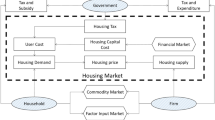Abstract
It was planned to build 36 million units of social welfare housing during the twelve-five 2011–2015 in China. This paper introduces the estimation of owner occupied dwelling sector and develops a dynamic computable general equilibrium model for China’s real estate and macro-economy, to simulate the policy effects. The simulation results show that this policy can meet the increased requirements of housing demand due to fast urbanization and improvement of living conditions, therefore it will effectively cool down the price boom of housing market. Meanwhile, although the investment on social welfare housing will reduce the investment on other sectors, it will still stimulate GDP growth.
Similar content being viewed by others
References
Lu J and Mi Y, The development situation and financing channels of the indemnificatory housing in China, Academic Journal Graduate School Chinese Academy of Social Sciences, 2011, 6: 56–60 (in Chinese).
Yang D and Zhang S, The study on construction of the affordable housing and its financing mode in China, Rural Finance Research, 2011, 10: 4–10 (in Chinese).
Ye X and Hu X, The dual constraints of land and capital for social welfare housing and its solutions, Wuhan Finance Monthly, 2011, 10: 4–6 (in Chinese).
Zhang W, The land supply problem of social welfare housing, China Land, 2011, 10: 19–21 (in Chinese).
Wang Z, The impact of China’s WTO entry on the world labour-intensive export market: A recursive dynamic CGE analysis, The World Economy, 1999, 22(3): 379–405.
Zhai F and Li S, The implications of accession to WTO on China’s economy, Third Annual Conference on Global Economic Analysis, June 27–30, 2000.
Zhang Z X, Macroeconomic effects of CO2 emission limits: A computable general equilibrium analysis for China, Journal of Policy Modeling, 1998a, 20(2): 213–250.
Wang K, Wang C, and Chen J, Analysis of the economic impact of different Chinese climate policy options based on a CGE model incorporating endogenous technological change, Energy Policy, 2009, 37(8): 2930–2940.
Zhang Z X, Macro-economic and sectoral effects of carbon taxes: A general equilibrium analysis for China, Economic Systems Research, 1998b, 10(2): 135–159.
Cao J, Essays on environmental tax policy analysis: Dynamic computable general equilibrium approaches applied to China, Ph.D Dissertation, Kennedy School, Harvard University, Nov. 2007.
Strutt A and Walmsley T, Implications of the global financial crisis for China: A dynamic CGE analysis to 2020, Economics Research International, 2011, October, 9 pages available online, doi:10.1155/2011/926484.
Zaouali S, Impact of higher oil prices on the Chinese economy, OPEC Review, 2007, 31(3): 191–214.
Zhai F and Wang Z, WTO accession, rural labour migration, and urban unemployment in China, Urban Studies, 2002, 39(12): 2199–2217.
Mayerhauser N and Reinsdorf M, Housing services in the national economic accounts, BEA working paper, 2007.
Eurostat Manual, Technical manual on owner-occupied housing, 2010, available at http://epp.eurostat.ec.europa.eu/portal/page/portal/hicp/documents/Tab/Tab/03 METH-OOHTECHMANUAL V1-9.pdf.
Woolford K, Treatment of owner-occupied housing in Australia -Concepts and practices, OECD seminar “Inflation Measures: Too High-Too Low-Internationally Comparable?” Paris, 21–22 June 2005.
Arai H, Estimating imputed rent for owner-occupied dwellings in the Japanese system of national accounts, ESRI Discussion Paper Series, Economic and Social Research Institute, Tokyo, Japan, 2005, 141.
Anas A and Amott R J, Taxes and allowances in a dynamic equilibrium model of urban housing with a size-quality hierarchy, Regional Science and Urban Economics, 1997, 27(4–5): 547–580.
Nechyba T J, Replacing capital taxes with land taxes: Efficiency and distributional implications with an application to the United States economy, Land Value Taxation: Can It Will Work Today? (ed. by Dick N) Cambridge (MA) Lincoln Institute of Land Policy, 1998.
Bye B and Avitsland T, The welfare effects of housing taxation in a distorted economy: A general equilibrium analysis, Economic Modelling, 2003, 20(5): 895–921.
Waters E C, Holland D W, and Weber B A, Economic impacts of a property tax limitation: A computable general equilibrium analysis of Oregon’s measure 5, Land Economics, 1997, 73(1): 72–89.
Thaiprasert N, Faulk D, and Hicks M J, An examination of the economic impact of property tax levy caps on economic activity in New Jersey, Ball State University, Working Paper, 2011.
Mai Y, Dixon P B, and Rimmer M, CHINAGEM: A monash-styled dynamic CGE model of China, CoPS General Paper, 2010, No. G-201, Available online at http://www.monash. edu.au/policy/ftp/workpapr/g-201.pdf.
Dixon P B, Parmenter B R, Sutton J, and Vincent D P, ORANI: A multisectoral model of the Australian economy, North-Holland, Amsterdam, 1982.
Dixon P B and Rimmer M, Dynamic general equilibrium modelling for forecasting and policy: A practical guide and documentation of MONASH, North-Holland Publishing Company, Amsterdam, 2002
Ahuja A, Cheung L, Han G, Porter N, and Zhang W, Are house prices rising too fast in China? IMF Working Paper, 2010, WP/10/274.
O’Connell M, A general equilibrium analysis of property tax in Florida, Ph.D Dissertation, University of Florida, 2007.
Author information
Authors and Affiliations
Corresponding author
Additional information
This research is supported by the Natural Science Foundation of China under Grant No. 71103176.
This paper was recommended for publication by Editor WANG Shouyang.
Rights and permissions
About this article
Cite this article
Jiang, X., Mai, Y. The social welfare housing project and its effects in China. J Syst Sci Complex 28, 393–408 (2015). https://doi.org/10.1007/s11424-014-3261-z
Received:
Revised:
Published:
Issue Date:
DOI: https://doi.org/10.1007/s11424-014-3261-z




